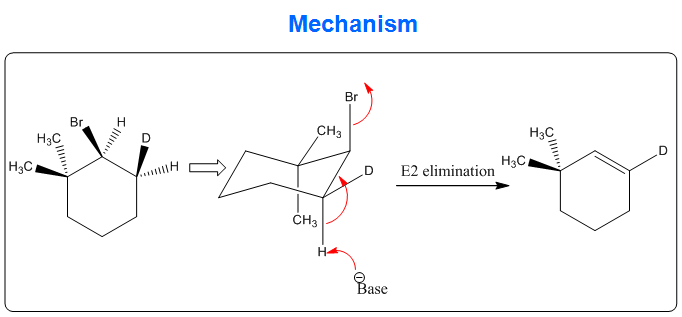The image is a structural representation of a cyclohexane ring with various substituents. The hexagon represents the cyclohexane ring, with each corner symbolizing a carbon atom. Attached to the ring are the following substituents: 1. **CH₃ (Methyl group)** – attached to the top left carbon with a solid wedge, indicating it is coming out of the plane towards the viewer. 2. **CH₃ (Methyl group)** – attached to the top right carbon with a dashed wedge, indicating it is going behind the plane away from the viewer. 3. **Br (Bromine)** – attached to the bottom right carbon with a solid wedge, indicating it is coming out of the plane towards the viewer. 4. **H (Hydrogen)** – attached to the same carbon as the bromine but with a dashed wedge, indicating it is going behind the plane. 5. **D (Deuterium)** – attached to the bottom carbon with a solid wedge, indicating it is coming out of the plane. 6. **H (Hydrogen)** – attached to the same carbon as deuterium but with a dashed wedge, indicating it is going behind the plane. The solid wedge demonstrates atoms or groups that project in front of the plane, while the dashed wedge indicates atoms or groups that project behind the plane of the cyclohexane ring. This stereochemical notation is crucial for understanding the three-dimensional orientation of the substituents.
The image is a structural representation of a cyclohexane ring with various substituents. The hexagon represents the cyclohexane ring, with each corner symbolizing a carbon atom. Attached to the ring are the following substituents: 1. **CH₃ (Methyl group)** – attached to the top left carbon with a solid wedge, indicating it is coming out of the plane towards the viewer. 2. **CH₃ (Methyl group)** – attached to the top right carbon with a dashed wedge, indicating it is going behind the plane away from the viewer. 3. **Br (Bromine)** – attached to the bottom right carbon with a solid wedge, indicating it is coming out of the plane towards the viewer. 4. **H (Hydrogen)** – attached to the same carbon as the bromine but with a dashed wedge, indicating it is going behind the plane. 5. **D (Deuterium)** – attached to the bottom carbon with a solid wedge, indicating it is coming out of the plane. 6. **H (Hydrogen)** – attached to the same carbon as deuterium but with a dashed wedge, indicating it is going behind the plane. The solid wedge demonstrates atoms or groups that project in front of the plane, while the dashed wedge indicates atoms or groups that project behind the plane of the cyclohexane ring. This stereochemical notation is crucial for understanding the three-dimensional orientation of the substituents.
Chemistry
10th Edition
ISBN:9781305957404
Author:Steven S. Zumdahl, Susan A. Zumdahl, Donald J. DeCoste
Publisher:Steven S. Zumdahl, Susan A. Zumdahl, Donald J. DeCoste
Chapter1: Chemical Foundations
Section: Chapter Questions
Problem 1RQ: Define and explain the differences between the following terms. a. law and theory b. theory and...
Related questions
Question
After E2 elimination, will the following molecule contain deuterium? Why or why not?

Transcribed Image Text:The image is a structural representation of a cyclohexane ring with various substituents. The hexagon represents the cyclohexane ring, with each corner symbolizing a carbon atom. Attached to the ring are the following substituents:
1. **CH₃ (Methyl group)** – attached to the top left carbon with a solid wedge, indicating it is coming out of the plane towards the viewer.
2. **CH₃ (Methyl group)** – attached to the top right carbon with a dashed wedge, indicating it is going behind the plane away from the viewer.
3. **Br (Bromine)** – attached to the bottom right carbon with a solid wedge, indicating it is coming out of the plane towards the viewer.
4. **H (Hydrogen)** – attached to the same carbon as the bromine but with a dashed wedge, indicating it is going behind the plane.
5. **D (Deuterium)** – attached to the bottom carbon with a solid wedge, indicating it is coming out of the plane.
6. **H (Hydrogen)** – attached to the same carbon as deuterium but with a dashed wedge, indicating it is going behind the plane.
The solid wedge demonstrates atoms or groups that project in front of the plane, while the dashed wedge indicates atoms or groups that project behind the plane of the cyclohexane ring. This stereochemical notation is crucial for understanding the three-dimensional orientation of the substituents.
Expert Solution
Step 1

Step by step
Solved in 2 steps with 1 images

Knowledge Booster
Learn more about
Need a deep-dive on the concept behind this application? Look no further. Learn more about this topic, chemistry and related others by exploring similar questions and additional content below.Recommended textbooks for you

Chemistry
Chemistry
ISBN:
9781305957404
Author:
Steven S. Zumdahl, Susan A. Zumdahl, Donald J. DeCoste
Publisher:
Cengage Learning

Chemistry
Chemistry
ISBN:
9781259911156
Author:
Raymond Chang Dr., Jason Overby Professor
Publisher:
McGraw-Hill Education

Principles of Instrumental Analysis
Chemistry
ISBN:
9781305577213
Author:
Douglas A. Skoog, F. James Holler, Stanley R. Crouch
Publisher:
Cengage Learning

Chemistry
Chemistry
ISBN:
9781305957404
Author:
Steven S. Zumdahl, Susan A. Zumdahl, Donald J. DeCoste
Publisher:
Cengage Learning

Chemistry
Chemistry
ISBN:
9781259911156
Author:
Raymond Chang Dr., Jason Overby Professor
Publisher:
McGraw-Hill Education

Principles of Instrumental Analysis
Chemistry
ISBN:
9781305577213
Author:
Douglas A. Skoog, F. James Holler, Stanley R. Crouch
Publisher:
Cengage Learning

Organic Chemistry
Chemistry
ISBN:
9780078021558
Author:
Janice Gorzynski Smith Dr.
Publisher:
McGraw-Hill Education

Chemistry: Principles and Reactions
Chemistry
ISBN:
9781305079373
Author:
William L. Masterton, Cecile N. Hurley
Publisher:
Cengage Learning

Elementary Principles of Chemical Processes, Bind…
Chemistry
ISBN:
9781118431221
Author:
Richard M. Felder, Ronald W. Rousseau, Lisa G. Bullard
Publisher:
WILEY